-

小班科学教案 挖土大力士
【活动准备】1、活动开展前教师和家长应带幼儿观察建筑工地。2、准备各种挖土工具的图书、图片、录像等资料。3、收集玩具挖土机。 【活动过程】1、导入:小朋友,你们见过挖土机吗?谁能说一说挖土机有什么本领?2、观看录象:在各种不同场所工作着的挖土机。 (1)请幼儿仔细观察挖土机是怎样工作的。 (2)请幼儿观察挖土机用什么挖土?像什么? (3)让幼儿学着挖土机按顺序作挖土的动作。 (4)引导幼儿用语言描述挖土机的样子以及它挖土的动作。
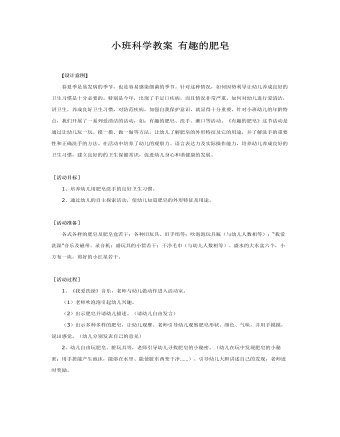
小班科学教案 有趣的肥皂
[活动目标] 1、培养幼儿用肥皂洗手的良好卫生习惯。 2、通过幼儿的自主探索活动,使幼儿知道肥皂的外形特征及用途。 [活动准备] 各式各样的肥皂及肥皂盒若干;各种旧玩具、旧手绢等;吹泡泡玩具瓶(与幼儿人数相等);“我爱洗澡”音乐及磁带、录音机;盛玩具的小筐若干;干净毛巾(与幼儿人数相等)、盛水的大水盆六个,小方布一块,剪好的小红星若干。 [活动过程]1、《我爱洗澡》音乐,老师与幼儿做动作进入活动室。 (1)老师吹泡泡引起幼儿兴趣。 (2)出示肥皂并请幼儿描述。(请幼儿自由发言) (3)出示多种多样的肥皂,让幼儿观摩。老师引导幼儿观察肥皂形状、颜色、气味,并用手摸摸,说出感觉。(幼儿分别发表自己的意见)
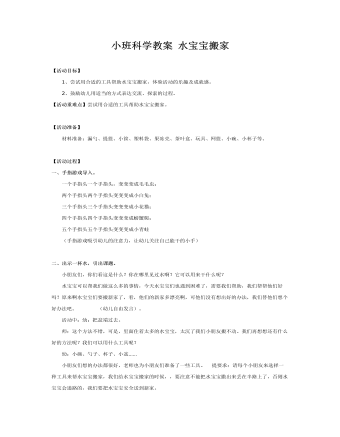
小班科学教案 水宝宝搬家
【活动重难点】尝试用合适的工具帮助水宝宝搬家。 【活动准备】 材料准备:漏勺、提篮、小筐、塑料袋、果冻壳、茶叶盒、玩具、网篮、小碗、小杯子等。 【活动过程】一、手指游戏导入。 一个手指头一个手指头,变变变成毛毛虫; 两个手指头两个手指头变变变成小白兔; 三个手指头三个手指头变变变成小花猫; 四个手指头四个手指头变变变成螃蟹爬; 五个手指头五个手指头变变变成小青蛙 (手指游戏吸引幼儿的注意力,让幼儿关注自己能干的小手) 二、出示一杯水,引出课题。 小朋友们,你们看这是什么?你在哪里见过水啊?它可以用来干什么呢? 水宝宝可以帮我们做这么多的事情,今天水宝宝们也遇到困难了,需要我们帮助,我们帮帮他们好吗?原来啊水宝宝们要搬新家了,看,他们的新家多漂亮啊,可他们没有想出好的办法,我们替他们想个好办法吧。 (幼儿自由发言)。 活动中:幼:把盆端过去。 师:这个方法不错,可是,里面住着太多的水宝宝,太沉了我们小朋友搬不动。我们再想想还有什么好的方法呢?我们可以用什么工具呢? 幼:小碗、勺子、杯子、小盆…… 小朋友们想的办法都很好,老师也为小朋友们准备了一些工具。 提要求:请每个小朋友来选择一种工具来帮水宝宝搬家,我们给水宝宝搬家的时候,,要注意不能把水宝宝撒出来丢在半路上了,否则水宝宝会迷路的,我们要把水宝宝安全送到新家。 下面请小朋友们跟老师一起做,小手小手伸出来,袖子袖子卷起来。
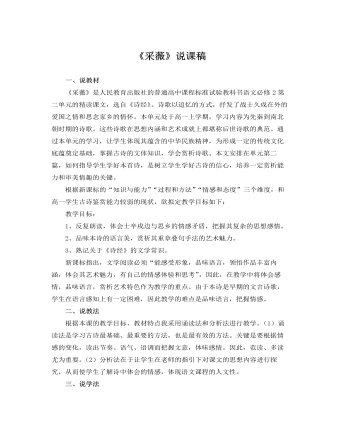
人教版高中语文必修2《采薇》说课稿
三、疏通课文,体会情感学生朗读一至三节,找出通假字,如“莫”;语助词如“止”“曰”;古今异义词如“启”“居”。以及个别短语如“靡室靡家”“载饥载渴”的结构,结合上《卫风·氓》中出现的相同或类似的结构来理解。检查学生的自学情况,抽查翻译,纠正错误。这三节都以采薇起笔,让学生思考课文呢写了薇菜生长的哪几种形态,有什么作用?学生思考。这个问题不难,但学生回答可能不完整,只点到用于表达士卒思归之情的强烈。老师要补充,用薇菜的生长来反映归期的推移和不定期,思念之情更加沉重。同时在艺术手法上,同《卫风·氓》用“桑叶”来起兴一样,这里也是比兴手法,引出下文。另外,战士们靠野菜来充饥也反映了战士们生活艰苦,兴中有赋。
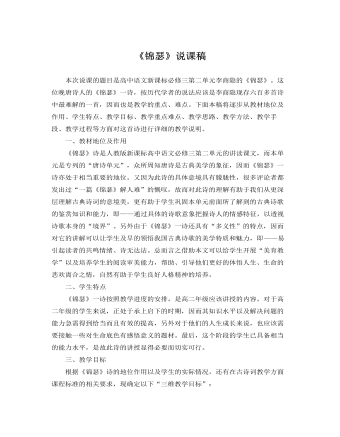
人教版高中语文必修3《锦瑟》说课稿
三、教学目标根据《锦瑟》诗的地位作用以及学生的实际情况,还有在古诗词教学方面课程标准的相关要求,现确定以下“三维教学目标”:(一)知识与技能目标:感受体悟古典诗歌的意境美,发挥合理的主观能动性进行创新性的阅读鉴赏,正确认识意象在诗歌意境中的重要作用。并在上述的基础上提高鉴赏能力和审美情操。(二)过程与方法目标:《锦瑟》诗的讲解采用“引导与自我生成”的方法,从老师的引导开始,以学生的研讨交流再加之教师的总结结束。利用教师引导和师生互动刺激学生的领悟力,提高学生的认知水平与能力。(三)情感态度价值观目标:培养学生在尊重传统文化的基础上热爱祖国自己文化的态度,让学生正确认识古典诗词的精神美。最后在自我感悟中陶冶情操,明心启智。
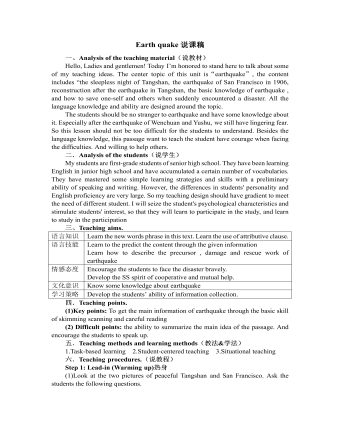
人教版高中英语必修1Earth quake说课稿
(4)Finally, I will ask the SS what this sentence mean:It is always calm before a storm.Purpose: attract the SS attention and bring them into discussionStep 2: Pre-reading 读前Here, I will do the second question in pre-reading first. I will use the method of brainstorming to ask the SS what will happen before an earthquake; and list the phenomenon on the table. 2. Then I will show the SS the picture of abnormal phenomenon, at the same time, encourage the SS to describe.3、finally, I will summarize these phenomenon4、Do the first question in the pre-reading , Imaging your home begins to shake and you must leave it right away. You have time to take only one thing. What will you take? Why?Purpose: help the SS to get further understanding of the topic and stimulate their interests.Step3: While-reading 阅读(1). Skimming Read the text quickly and catch the meaning of the first and second sentence of each paragraph. Predict the meaning of new words(2).scanning(找读)A. Read the text again. Do the following question.1. When and where were the strange things happening?2. What are they?3. Why did the text say the world seemed to be at an end?4. How was the city destroyed after the quake?5. When did the second quake hit the city? What was the result of that?6. Who came to help Tangshan first? And how?B. Work in pairs to discuss the question.
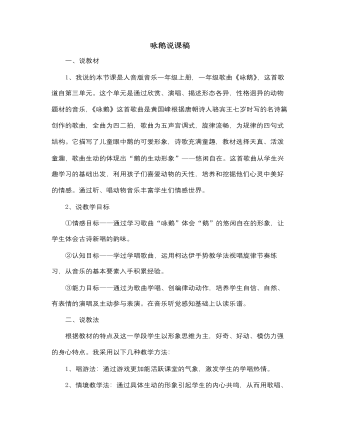
人音版小学音乐一年级上咏鹅说课稿
④生分为两组,一组用手模仿鹅嘴巴上下合闭的动作。边念嘎嘎……另一组用响板在同样的地方X X X | X O |配合。一起合作创造丰富歌曲的音响效果,培养了学生间的协作能力。(这一环节师弹琴,生边唱边合作,完整的一首歌曲)。4、律动创编教学。①让学生模仿一下,自己观察过鹅的各种各样的动作神态,用肢体初步体验。②模仿得太好了。我们一起来欣赏一下,舞蹈演员们是如何通过舞蹈动作模仿美丽的天鹅。出示多媒体课件——播放相关的视频,如芭蕾舞“四小天鹅”或“天鹅湖的片段”等。3、师:他们的舞姿太美了,我们也为我们这首歌曲创编上好看的动作吧。①根据歌词内容引导学生一段段创编动作。②教师可以指导完成律动创编,并且师表演一遍自己创编的律动。③师生随着音乐,进行律动,学生可以模仿老师的动作,也可以加上自己创编的动作。完整的演艺律动,从听觉、视觉和肢体知觉感受这首歌曲。(师示范一遍律动)
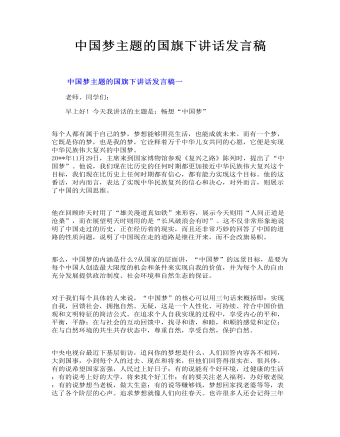
中国梦主题的国旗下讲话发言稿
对于我们每个具体的人来说,“中国梦”的核心可以用三句话来概括即:实现自我,回馈社会,拥抱自然。无疑,这是一个人性化、可持续、符合中国价值观和文明特征的简洁公式。在追求个人自我实现的过程中,享受内心的平和,平衡,平静;在与社会的互动回馈中,找寻和谐,和睦,和顺的感觉和定位;在与自然环境的共生共存状态中,尊重自然,享受自然,保护自然。

大班科学教案:环保教育:纸的由来
活动目标: 1、培养幼儿热爱祖国、热爱家乡的情感,珍惜每一份资源,做到不浪费,养成良好的环境意识。 2、培养其口头表述能力,通过听故事,能独立的完整的将大意概述出来。 3、了解纸的由来,学会利用纸,包括废物利用和循环利用。 活动准备: 各种各样的纸、剪刀等,造纸故事,造纸图、蔡伦图、颜料、桶。 活动过程: 一.谜语导入:引出“纸”。 “有个用具它不简单,可以写字,还可以把数算。 订起来是一本书,拆开来是一张张, 它是谁,我们都来猜猜看。”
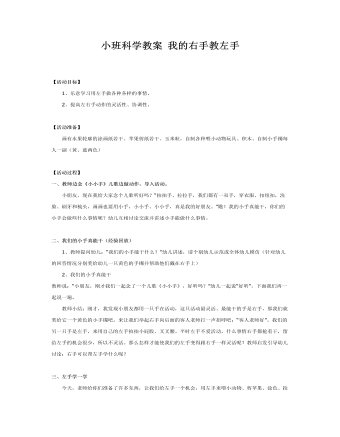
小班科学教案 我的右手教左手
2、提高左右手动作的灵活性、协调性。 【活动准备】 画有水果轮廓的涂画纸若干、苹果剪纸若干、玉米粒,自制各种喂小动物玩具、积木、自制小手镯每人一副(黄、蓝两色) 【活动过程】一、教师边念《小小手》儿歌边做动作,导入活动。 小朋友,现在我给大家念个儿歌听好吗?“拍拍手、拉拉手,我们都有一双手,穿衣服、扣纽扣,洗脸、刷牙和梳头,画画也要用小手,小小手、小小手,真是我的好朋友。”瞧!我的小手真能干,你们的小手会做些什么事情呢?幼儿互相讨论交流并讲述小手能做什么事情。
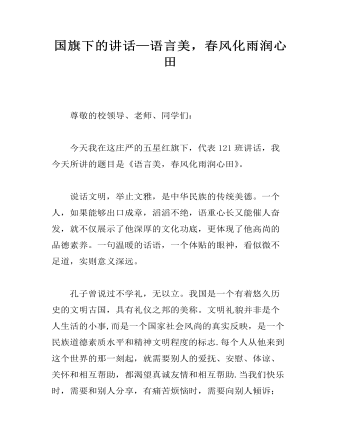
国旗下的讲话—语言美,春风化雨润心田
尊敬的校领导、老师、同学们:今天我在这庄严的五星红旗下,代表121班讲话,我今天所讲的题目是《语言美,春风化雨润心田》。说话文明,举止文雅,是中华民族的传统美德。一个人,如果能够出口成章,滔滔不绝,语重心长又能催人奋发,就不仅展示了他深厚的文化功底,更体现了他高尚的品德素养。一句温暖的话语,一个体贴的眼神,看似微不足道,实则意义深远。孔子曾说过不学礼,无以立。我国是一个有着悠久历史的文明古国,具有礼仪之邦的美称。文明礼貌并非是个人生活的小事,而是一个国家社会风尚的真实反映,是一个民族道德素质水平和精神文明程度的标志.每个人从他来到这个世界的那一刻起,就需要别人的爱抚、安慰、体谅、关怀和相互帮助,都渴望真诚友情和相互帮助.当我们快乐时,需要和别人分享,有痛苦烦恼时,需要向别人倾诉
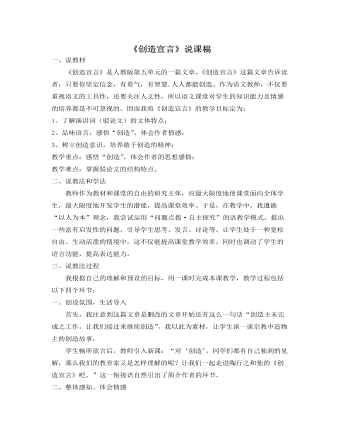
部编版语文九年级上册《创造宣言》说课稿
一、说教材《创造宣言》是人教版第五单元的一篇文章。《创造宣言》这篇文章告诉读者:只要你坚定信念,有勇气,有智慧.人人都能创造。作为语文教师,不仅要重视语文的工具性,还要关注人文性,所以语文课堂对学生的知识能力及情感的培养都是不可忽视的。因而我将《创造宣言》的教学目标定为:1、了解演讲词(驳论文)的文体特点;2、品味语言,感悟“创造”,体会作者情感;3、树立创造意识,培养敢于创造的精神;教学重点:感悟“创造”,体会作者的思想感情;教学难点:掌握驳论文的结构特点。二、说教法和学法教师作为教材和课堂的自由的研究主体,应最大限度地使课堂面向全体学生,最大限度地开发学生的潜能,提高课堂效率。于是,在教学中,我遵循“以人为本”理念,我尝试运用“问题点拨·自主探究”的语教学模式。提出一些富有启发性的问题,引导学生思考、发言、讨论等。
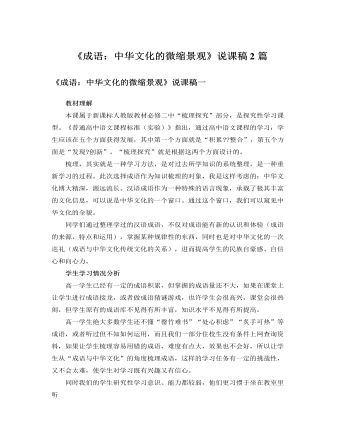
人教版高中语文必修2《成语:中华文化的微缩景观》说课稿2篇
(三)教学目标1、明确成语的来源,了解成语的结构特点。2、学习积累成语的方法。3、梳理学习过的成语,做到能正确理解、使用所学的常用成语。(四)教学重点和难点1、学习积累成语的方法。2、正确理解、使用所学的常用成语。二、说教法新的《高中语文课程标准》要求学生主动去发现问题、解决问题,教师是课堂学习的组织者、参与者,是课堂的主导,而不是课堂的主体。而且,新的课程标准要求学生“能围绕所选择的目标加强语文积累,在积累的过程中,注重梳理”。在这种前提下,本节课可以采取以下方法:由于这种梳理是对学生已有的知识进行归纳分类,可能显得比较枯燥。为了避免这种枯燥感,可以采取设置情境和分组竞答的方法,调动学生的积极性。

新人教版高中英语必修3Unit 1 Festivals and Celebrations教学设计二
1. Ss look at the picture and scan the passage to understand the main idea while teacher is giving the following questions to inspire Ss to think.*Where are those people?*What are they doing?*Why are they so excited?2. Ss complete the passage with the appropriate -ing form. Then discuss and check the answers with class.Answers: boring, interesting, taking, exciting, amazing3. The teacher raises questions for the students to discuss and encourages them to express their opinions.*Do you like La Tomatina? Why or why not?4. Each group representative reports the discussion result, the teacher gives feedback and the evaluation.Step 6 PracticeActivity 41. Ss complete the Ex 2 in Using structures.2. Check the answers after finishing the exercises.①The dragon boat races are the most exciting part of the Dragon Boat Festival.② The children were excited to go Easter egg hunting.③What an amazing performance! This is the best music festival I have ever been to.④We were amazed by her funny-looking hat.⑤His inspiring speech at the conference won the admiration/ favour of the audience.⑥This is a challenging game to test your memory and observation capabilities. 3. T asks Ss to finish Ex 3 and 4 in Using structures by themselves, then check the answers with class.Step 6 Homework1. Understand and master the functions and usage of the -ing form;2. Finish the other exercises in Using structures.1、通过本节内容学习,学生是否理解和掌握动词-ing形式作定语和表语的功能和意义;2、通过本节内容学习,学生能否在理解文段内容的基础上,根据上下文语境和表达逻辑,能正确运用动词-ing形式描述节日庆典。3、通过本节内容学习,学生是否归纳和积累用于表达情绪的相关词汇。

新人教版高中英语必修3Unit 1 Festivals and Celebrations教学设计一
本板块的活动主题是“谈论节日活动”(Talk about festival activities),主要是从贴近学生日常生活的角度来切入“节日”主题。学生会听到发生在三个国家不同节日场景下的简短对话,对话中的人们正在参与或将要亲历不同的庆祝活动。随着全球化的进程加速,国际交流日益频繁,无论是国人走出国门还是外国友人访问中国,都已成为司空见惯的事情。因此,该板块所选取的三个典型节日场景都是属于跨文化交际语境,不仅每组对话中的人物来自不同的文化背景,对话者的身份和关系也不尽相同。1. Master the new words related to holiday: the lantern, Carnival, costume, dress(sb)up, march, congratulation, congratulate, riddle, ceremony, samba, make - up, after all. 2. To understand the origin of major world festivals and the activities held to celebrate them and the significance of these activities;3. Improve listening comprehension and oral expression of the topic by listening and talking about traditional festivals around the world;4. Improve my understanding of the topic by watching pictures and videos about different traditional festivals around the world;5. Review the common assimilation phenomenon in English phonetics, can distinguish the assimilated phonemes in the natural language flow, and consciously use the assimilation skill in oral expression. Importance:1. Guide students to pay attention to the attitude of the speaker in the process of listening, and identify the relationship between the characters;2. Inspire students to use topic words to describe the festival activities based on their background knowledge. Difficulties:In the process of listening to the correct understanding of the speaker's attitude, accurately identify the relationship between the characters.

新人教版高中英语必修3Unit 2 Morals and Virtues教学设计二
Activity 41. Students complete the task of activity 4, then teachers and students check the answers. 2. The teacher organized the students to work together and asked them to use the tables and mind maps sorted out before to retold the important choices in Lin Qiaozhi's life and their resultsStep 5 Language points1. The teacher asks the students to read the text carefully, find out the core words and long and difficult sentences in the text and draw lines, understand the use of vocabulary, and analyze the structure of long and difficult sentences. 2. The teacher explains and summarizes the usage of core vocabulary and asks the students to take notes. 3. The teacher analyzes and explains the long and difficult sentences that the students don't understand, so that the students can understand them better. Step 6 Homework1. Read the text again, in-depth understanding of the text; 2. Master the use of core vocabulary and understand the long and difficult sentences. 3. Complete relevant exercises in the guide plan. 1、通过本节内容学习,学生是否理解和掌握阅读文本中的新词汇的意义与用法;2、通过本节内容学习,学生能否结合文本特点总结林巧稚的人生原则和人格品质特征;3、通过本节内容学习,学生能否针对人生抉择发表自己的看法;能否全面地、客观地、理性地看待问题,进而对道德和人性有更加深入的思考和理解。

新人教版高中英语必修3Unit 1 Festivals and Celebrations教学设计三
*wide range of origins(= a great number of different origins, many kinds of origins)*It featured a parade and a great feast with music, dancing, and sports. (=A parade and a great feast with music, dancing, and sports were included as important parts of the Egyptian harvest festival.)*.. some traditions may fade away and others may be established.(= Some traditions may disappear gradually, while other new traditions may come into being.)Step 6 Practice(1) Listen and follow the tape.The teacher may remind the students to pay attention to the meaning and usage of the black words in the context, so as to prepare for the completion of the blanks in activity 5 and vocabulary exercises in the exercise book.(2) Students complete the text of activity 5 by themselves.The teacher needs to remind the students to fill in the blanks with the correct form of the vocabulary they have learned in the text.Students exchange their answers with their partners, and then teachers and students check their answers.(3)Finish the Ex in Activity 5 of students’ book.Step 7 Homework1. Read the text again, in-depth understanding of the text;2. Discuss the origin of festivals, the historical changes of related customs, the influence of commercial society on festivals and the connotation and essential meaning of festivals.3. Complete relevant exercises in the guide plan.1、通过本节内容学习,学生是否理解和掌握阅读文本中的新词汇的意义与用法;2、通过本节内容学习,学生能否结合文本特点快速而准确地找到主题句;3、通过本节内容学习,学生能否理清论说文的语篇结构和文本逻辑,了解节日风俗发展与变迁,感悟节日的内涵与意义。

新人教版高中英语必修3Unit 2 Morals and Virtues教学设计三
The joke set her crying.这个玩笑使她哭起来。Step 5 ReadingActivity 31. Students read the small text in activity 3. The teacher provides several small questions to check whether students understand the content of the text and the ideographic function of the -ing form in the text.*Where are those people?*Why did Dr Bethune come to China?*How did he help the Chinese people during the war?*What did Chairman Mao Zedong say about him?2. Ss try to rewrite some sentences using the -ing form. Then check the answers. When checking the answers, the teacher can ask different students to read the rewritten sentences and give comments.Answers:1. he became very interested in medicine, deciding to become a doctor.2. …after hearing that many people were dying in the war.3. Helping to organise hospitals, he taught doctors and nurses, and showed people how to give first aid./ He helped to organise hospitals, teaching doctors and nurses, and showing people how to give first aid.4. …praising Dr Bethune as a hero to be remembered in China.Step 6 PracticeActivity 4Students complete grammar activities 2 and 3 on page 69 of the workbook.Step 6 Homework1. Understand and master the functions and usage of the -ing form;2. Finish the other exercises in Using structures.1、通过本节内容学习,学生是否理解和掌握动词-ing形式作宾语补足语语和状语语的功能和意义;2、通过本节内容学习,学生能否正确使用动词-ing形式描述人物的行为、动作及其经历;3、通过本节内容学习,学生能否独立完成练习册和导学案中的相关练习。

新人教版高中英语必修3Unit 2 Morals and Virtues教学设计四
3.Teachers ask different groups to report the answers to the questions and ask them to try different sentence patterns.The teacher added some sentence patterns for students to refer to when writing.Step 4 Writing taskActivity 51.Write the first draft.Students first review the evaluation criteria in activity 5, and then independently complete the draft according to the outline of activity 4, the answers to the questions listed in the group discussion and report, and the reference sentence pattern.2.Change partners.The teacher guides the students to evaluate their partner's composition according to the checklist of activity 5 and proposes Suggestions for modification.3.Finalize the draft.Based on the peer evaluation, students revise their own compositions and determine the final draft.Finally, through group recommendation, the teacher selects excellent compositions for projection display or reading aloud in class, and gives comments and Suggestions.Step 5 Showing writingActivity 5T call some Ss to share their writing.Step 6 Homework1. Read the passage in this section to better understand the passage.2. Carefully understand the hierarchical structure of the article, and deeply understand the plot of the story according to the causes, process and results;3. Independently complete the relevant exercises in the guide plan.1、通过本节内容学习,学生是否理解和掌握阅读文本中的新词汇的意义与用法;2、通过本节内容学习,学生能否通过人物言行的对比分析道德故事的深层内涵;3、通过本节内容学习,学生能否根据故事的起因、经过和结果来深入理解故事的情节,从而了解文章的层次结构;4、结合现实生活案例发表自己的见解和看法,写一篇观点明确、层次分明的故事评论。

新人教版高中英语必修3Unit 2 Morals and virtues教学设计一
(2) students are divided into groups according to the requirements of activity 3. Each student shares a story of personal experience or hearing-witnessing kindness, and then selects the most touching story in the group and shares it with the whole class. Before the students share the story, the teacher can instruct them to use the words and sentence patterns in the box to express. For example, the words in the box can be classified:Time order: first of all, then, after that, later, finally logical relationship :so, however, although, butTeachers can also appropriately add some transitional language to enrich students' expression:Afterwards, afterwards, at last, in the end, eventuallySpatial order: next to, far from, on the left, in front ofOtherwise, nevertheless, as a result, therefore, furthermore, in addition, as well asSummary: in a word, in short, on the whole, to sum up, in briefStep 8 Homework1. Understand the definition of "moral dilemma" and establish a correct moral view;2. Accumulate vocabulary about attitudes and emotions in listening texts and use them to express your own views;3. Complete relevant exercises in the guide plan.1、通过本节内容学习,学生能否理解理解“道德困境”的定义;2、通过本节内容学习,学生能否通过说话人所表达的内容、说话的语气、语调等来判断其态度和情绪;3、通过本节内容学习,学生能否针对具体的道德困境发表自己的看法和见解,能否掌握听力理训练中的听力策略。

